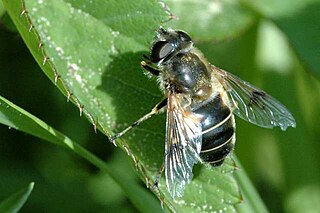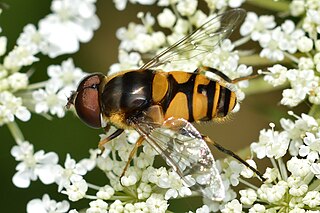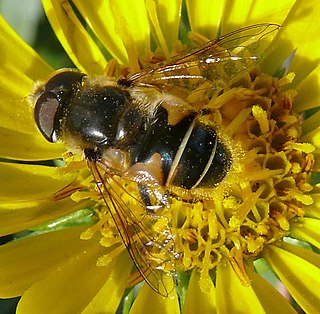
Hover flies, also called flower flies or syrphid flies, make up the insect family Syrphidae. As their common name suggests, they are often seen hovering or nectaring at flowers; the adults of many species feed mainly on nectar and pollen, while the larvae (maggots) eat a wide range of foods. In some species, the larvae are saprotrophs, eating decaying plant and animal matter in the soil or in ponds and streams. In other species, the larvae are insectivores and prey on aphids, thrips, and other plant-sucking insects.

Bill Gates' flower fly is a flower fly endemic to Costa Rica named after Bill Gates. Another fly found in similar habitats was named after Gates' associate Paul Allen, called Paul Allen's flower fly ; according to Chris Thompson, the describer of these species, both names were in "recognition of [their] great contributions to the science of Dipterology".

Eristalis is a large genus of hoverflies, family Syrphidae, in the order Diptera. Several species are known as drone flies because they bear a resemblance to honeybee drones.

Eristalis tenax, the common drone fly, is a common, migratory, cosmopolitan species of hover fly. It is the most widely distributed syrphid species in the world, and is known from all regions except the Antarctic. It has been introduced into North America and is widely established. It can be found in gardens and fields in Europe and Australia. It has also been found in the Himalayas.

Hover flies of the genus Microdon are unusual among the Diptera. Like other members of the subfamily, they are myrmecophiles, meaning they inhabit the nests of ants.

Eristalinae are one of the four subfamilies of the fly family Syrphidae, or hoverflies. A well-known species included in this subfamily is the dronefly, Eristalis tenax.

Eristalis arbustorum, the European drone fly, is an abundant Northern Hemisphere species of syrphid fly, originally officially described by Linnaeus in 1758 as Musca arbustorum. The name "drone fly" is related to its similar appearance to the drone of the honeybee. Hoverflies get their names from the ability to remain nearly motionless while in flight. The adults are also known as flower flies as they are commonly found on and around flowers from which they get both energy-giving nectar and protein rich pollen. The larvae are aquatic filter-feeders of the long-tailed type.

Eristalis rupium, commonly known as the spot-winged drone fly, is a species of syrphid fly that was first described by Fabricius in 1805. It is a common European species, and uncommon in North America. Hoverflies get their names from the ability to remain nearly motionless while in flight. The adults are also known as flower flies as they are commonly found around and on flowers, from which they get both energy-giving nectar and protein-rich pollen. The larvae are aquatic filter-feeders of the rat-tailed type, found in streams with clear water.

Eristalini is a tribe of hoverflies. Several species are well-known honeybee mimics, such as the drone fly Eristalis tenax, while other genera such as Helophilus and Parhelophilus exhibit wasp-like patterns of yellow and black stripes, both strategies to avoid predation by visual predators such as birds.

Palpada is a genus of 85 neotropical and nearctic flower flies or hoverflies This genus is often colorful and bee-like. It is in the tribe Eristaliini containing dozens of genera Common sister genera include Eristalis (99 species), Meromacrus (43 sp.), Eristalinus (100 sp.) and Helophilus (50 sp.). The genus palpada is distinguished by:
Neoascia metallica, the Double-banded Fen Fly, is a common species of syrphid fly observed across North America. Hoverflies can remain nearly motionless in flight. The adults are also known as flower flies, for they are commonly found on flowers, from which they get both energy-giving nectar and protein-rich pollen. The larvae are aquatic.

Eristalis transversa, the transverse banded drone fly, is a common species of syrphid fly first officially described by Wiedemann in 1830. Hoverflies get their names from the ability to remain nearly motionless while in flight. The adults are also known as flower flies for they are commonly found around and on flowers, from which they get both energy-giving nectar and protein-rich pollen. The larvae are rat-tailed type but larvae of this specific species has not been reported.

Eristalis bellardii, the Mexican mountain drone fly, is an uncommon species of syrphid fly first officially described by Jaennicke in 1867. It is infrequently found in the Southwestern United States, Mexico and Central America. In appearance it is somewhat like that of a honeybee. Hoverflies get their names from the ability to remain nearly motionless while in flight. The adults are also known as flower flies for they are commonly found around and on flowers, from which they get both energy-giving nectar and protein-rich pollen.

Eristalis dimidiata, the black-shouldered drone fly, is a species of hoverfly native to much of Canada and the eastern and northern United States. It flies year-round in southern areas and from late March to mid-November further north. It is one of the earliest hoverflies to fly in the spring, and as such likely overwinters as an adult. It lives primarily in forests.

'Eristalis saxorum, the Blue-polished Drone Fly, is an uncommon species of syrphid fly found along the Eastern United States. Hoverflies get their names from the ability to remain nearly motionless while in flight. The adults are also known as flower flies for they are commonly found around and on flowers, from which they get both energy-giving nectar and protein-rich pollen. The larvae are aquatic filter-feeders of the rat-tailed type. The larvae of this species have not been identified. Little is known about this uncommon species which flies from mid-March to late October.

Eristalis obscura, the dusky drone fly, is a common species of syrphid fly first officially described by Loew in 1866. This species is widespread in the northern part of North America and Europe east to Siberia. Hoverflies get their names from the ability to remain nearly motionless while in flight. The adults are also known as flower flies for they are commonly found around and on flowers from which they get both energy-giving nectar and protein-rich pollen. The larvae are aquatic filter-feeders of the rat-tailed type.

Eristalis hirta, the black-footed drone fly, is a common Western North American species of syrphid fly, first officially described by Loew in 1866. Hoverflies get their names from the ability to remain nearly motionless while in flight. The adults are also known as flower flies as they are commonly found on and around flowers, from which they get both energy-giving nectar and protein-rich pollen. The larvae are aquatic filter-feeders of the rat-tailed type.

Eristalis brousii, also called the hourglass drone fly or flower fly, is a species of syrphid fly largely eliminated in most of its former range except in northern Canada. It was first officially described by Williston in 1882. The cognomen "flower fly" derives from the fact that the flies are commonly found on and surrounding flowers from which they source energy-restoring nectar and protein-rich pollen. The larvae are aquatic filter-feeders of the rat-tailed sort.
Total of 245 species either found or highly expected to be found in New York.
















